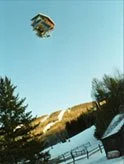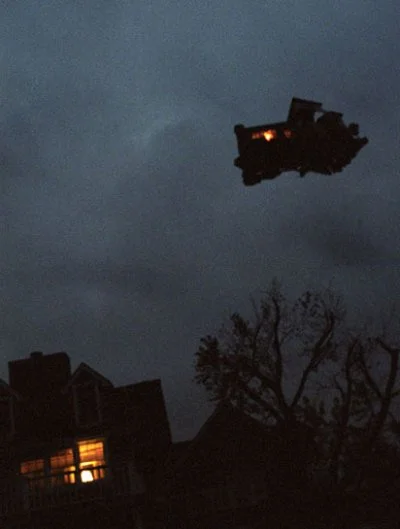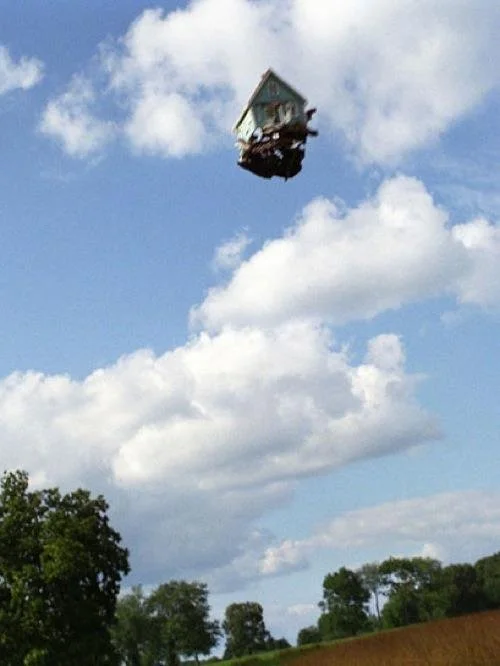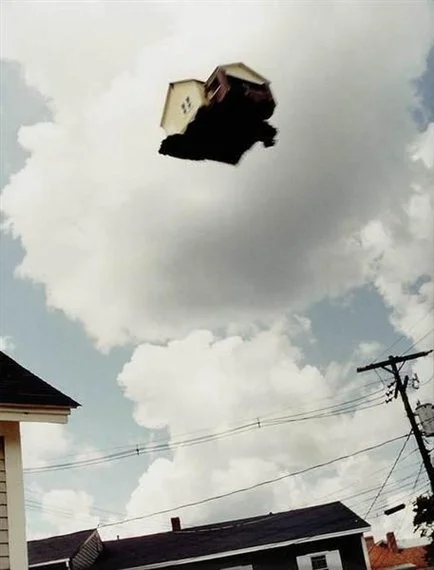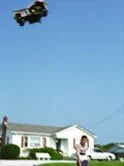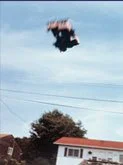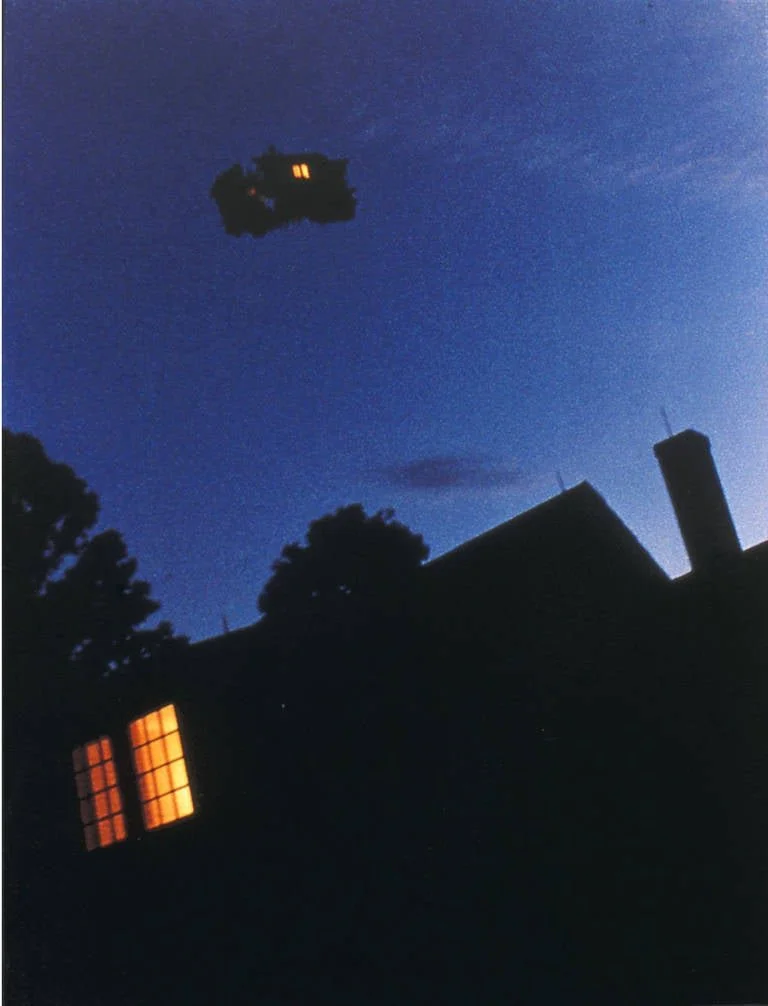
MOBILE HOME INTRODUCTION BY ALEXANDER UHRWhen I first saw Peter Garfield’s “Mobile Home” photographs two years ago, I was immediately drawn in by his lightness of touch. Presented with a disarming nonchalance, these images of suburban houses flying through the sky possessed a humorous innocence — whimsy, even — that directed my attention. And yet there was something too normal about these photographs of very extraordinary occurrences. A disturbing mundaneness colored the otherwise cheerful buoyancy of these fantastic images. Was I witness to a disaster or a dream? The incongruity of the airborne domiciles with sunny blue skies and innocuous cottony clouds seemed to rule out an act of nature. Perhaps it was some man-made catastrophe of a scale only made possible by late twentieth-century technology. In the absence of any definitive answers, I was left with an alternately thrilling and discomfiting sensation — thrilled at seeing a remarkable event, discomfited that I could not interpret exactly what I saw.It is what Garfield explicitly does not show in his images that allows the homes their mobility. Only recently, when the artist invited me to observe the creation of some of these pictures, was I able to see beyond the frame. Arriving at what seemed the set of a low-budget disaster movie, I was faced with a whirlwind of activity and purpose. A team of workers — engineers, riggers, crane operators, carpenters — had been assembled expressly to stage the mise-en-scene for Garfield’s photographs. The object of all the commotion, a modest white clapboard house, sat detached and forlorn, perched on blocks and trusses. Ultimately, the effort and expense effected their intended objective: the house was slowly lifted upwards and suspended while final preparations were made. Finally released, it crashed down to earth where timbers, sheetrock, and glass shattered and flew to the four corners of the site. And during the awesome sound and fury of a house falling out of the sky, Garfield intently shot what would become the latest in his series of “Mobile Homes.”Certainly the precedents of conceptual and earth art of the early 1970s bear upon Garfield’s project. Robert Smithson’s Partially Buried Woodshed (1971) or Gordon Matta-Clark’s Splitting (1973) handily anticipate Garfield’s destructive relationship with domestic architecture. The grand macho gestures of artists such as Michael Heizer and Chris Burden might also be seen as relevant forebears. But while these precedents embraced process and its documentation as an integral part of their meaning, Garfield has heretofore entirely repressed and concealed process. All the manpower and heavy machinery — trucks, cranes, even helicopters —that would have been very much in evidence in the critical reception of that earlier work, has in Garfield’s photographs been cropped out, almost obsessively erased.“The idea of absence, a substantive lack of something, has always intrigued me,” (1) the artist has written, and it is precisely an absence, a substantive lack of context that produces the photographs’ frisson, the jarring incongruity of the image. And this, in itself, brings to mind the further incongruity of enormous expenditure of resources for the sake of a single picture. Defying a temperate sense of logic and proportion, Garfield’s process invokes the almost comic absurdity of his practice.Our understanding of Garfield’s process — previously intuited, if not actually known — stands as an essential component of his images. This understanding is necessarily both present and suspended in the apprehension of the still and isolated image, and the oscillation between knowing and not knowing embodies a paradox that suffuses his project, forming, in a sense, its own dialectic. But while absurdity, paradox, and art permeate Garfield’s practice, it nonetheless also involves a substantial amount of very real physical risk and the visceral reactions that induces. The clear and present dangers of dropping even a small house confer a certain gravity upon the participants and the viewer. Wonder and foreboding accompany the raising of the house several hundred feet, as they do the ascension of any massive object that has no business in the sky above us. Who has not had the sensation upon watching a passenger plane overhead that such an ungainly hulk is surely not meant to fly, or wondered if the laws of physics might suddenly reassert themselves and cause the plane to nosedive to earth in an explosive fireball? (And who has not felt this same sentiment as a passenger?) In his “Mobile Homes,” Garfield gives us this improbable moment. He indulges our secret desire to see the plane crash (or a house fall from the sky). But he does so only fractionally, picturing neither the deliberate beginning nor the chaotic end, allowing us solely a view of the dilated, present-tense, indecisive instant.This uncanny extended moment (which one remembers as silent, although it is not) between the release of the cables and the terrible crash is the one captured in the printed photograph, whose existential condition is, as Roland Barthes observed, a “strange stasis, the stasis of an arrest.” (2) Garfield’s images are movie stills, enigmatic fragments of an unfinished narrative. They thwart desire for the closure of even partial interpretation, and it is their frustrating indeterminacy that may be at the heart of Garfield’s project.The “Mobile Homes” hint at some statement of a vernacular sublime, but existing as only photograph, unlatched from the narrative in which they should cohere, they remain, in Barthes’s words, a “message sans code,” (3) ungoverned by the cultural conventions that ought to dictate their consumption. And yet, while these floating images insinuate a certain transcendence, their condition as documentary photograph — evinced by the casual composition, the blur and the grain, and the washed-out colors — imply the prosaic brutality of their making and, ultimately, their meaning. It is, perhaps, this double-edged aspect of Garfield’s work that John Paul Ricco associates with “the reciprocal relations between idealization and violence. . . idealization as it is projected across check-out line glamour magazines and onto the not-so-big screens of suburban multiplex cinemas. . . and violence as a feeble last attempt to fight downward mobility and the anxieties that accompany dreams which turn into nightmares.” (4) Confronted by the ambivalence and ambiguity of Peter Garfield’s “Mobile Homes,” we sit in suspended judgement of the character of their content. Alexander Uhr is Associate Professor of Aesthetics and Critical Theory at the Akademie der Künste, Stuttgart. He is the author of Tabloid Aesthetic: The Object of Art in the Information Age (Cologne: Günter Verlag, 1996). He lives in Germany and New York.
1) Letter to the author, 12 September 1997.
2) Camera Lucida: Reflections on Photography, trans. Richard Howard (New York: The Noonday Press, 1981), p. 91.
3) This concept of the fundamentally uncoded nature of the photographic image may be found in “Rhétorique d l’image,” Communications, no. 4 (1964), pp. 40-51. I am indebted to Rosalind Krauss’s explication of Barthes in “Notes on the Index: Seventies Art in America, Part 2,” October, no. 4 (Fall 1977), p. 59.
4) “Negative, Desired,” Photography Quarterly 69, vol. 17, no. 4 (1997), pp. 10-11.night blooming jasmine
night blooming jasmine
THREE SIX FIVE ZERO
BY CONOR O’CALLAGHAN, 2009
I called up tech and got the voicemail code. It’s taken me this long to find my feet. Since last we spoke that evening it has snowed. Fifty-four new messages. Most are old and blinking into a future months complete. I contacted tech to get my voicemail code to hear your voice, not some bozo on the road the week of Thanksgiving dubbing me his sweet and breaking up and bleating how it snowed the Nashville side of Chattanooga and slowed the beltway to a standstill. The radio said sleet. The kid in tech sent on my voicemail code. I blew a night on lightening the system’s load, woke to white enveloping the trees, the street that’s blanked out by my leaving. It had snowed. Lately others’ pasts will turn me cold. I heard out every message, pressed delete. I’d happily forget my voice, the mail, its code. We spoke at last that evening. Then it snowed.You better be careful, or you might have a near life experience!
i wanna live in an ancient suburb
i wanna live in an ancient suburb
ALL HORSES ARE THE SAME COLOR
VIA WIKIPEDIA
All horses are the same color is a falsidical paradox that arises from a flawed use of mathematical induction to prove the statement All horses are the same color.[1] There is no actual contradiction, as these arguments have a crucial flaw that makes them incorrect. This example was originally raised by George Pólya in a 1954 book in different terms: "Are any n numbers equal?" or "Any n girls have eyes of the same color", as an exercise in mathematical induction.[2] It has also been restated as "All cows have the same color".[3]
The "horses" version of the paradox was presented in 1961 in a satirical article by Joel E. Cohen. It was stated as a lemma, which in particular allowed the author to "prove" that Alexander the Great did not exist, and he had an infinite number of limbs.[4]
Łukowski, Piotr (2011). Paradoxes. Springer. pp. 15.
Pólya, George (1954). Induction and Analogy in Mathematics. Princeton University Press. p. 120.
Thomas VanDrunen, Discrete Mathematics and Functional Programming, Franklin, Beedle and Associates, 2012, Section "Induction Gone Awry"
Cohen, Joel E. (1961), "On the nature of mathematical proofs", Worm Runner's Digest, III (3). Reprinted in A Random Walk in Science (R. L. Weber, ed.), Crane, Russak & Co., 1973, pp. 34-36tilting a hard drive to help the data flow



